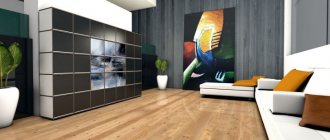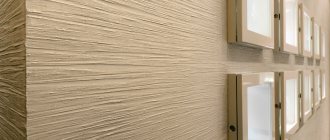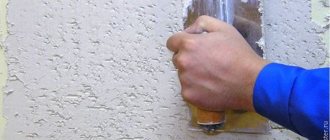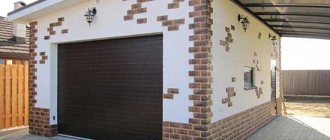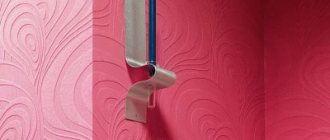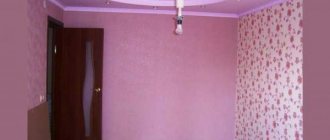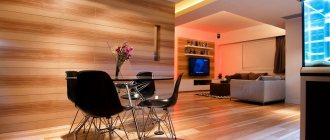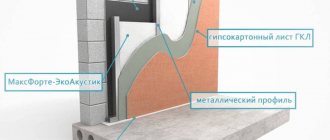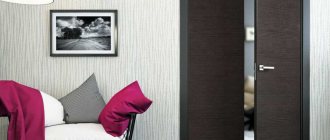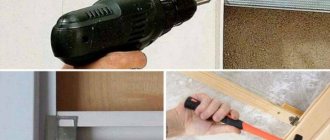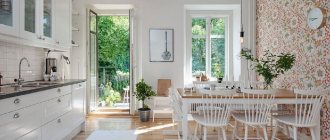Even the smallest errors on the walls will be visible when painting them, so the preparatory process is very important before painting.
If there are flaws on the wall, then even the most expensive paint or the most expensive materials will not save it. Today in stores you can buy different types of materials, thanks to which you can level the walls for painting.
In order not to get lost in a large number of materials, you need to know the leveling procedure itself and the features of certain mixtures.
Creating a flat surface
In new houses that have just been built, as well as in some old apartments, the quality of wall coverings is not the best.
There are different differences on the walls, in some cases reaching 2-5 cm.
In addition, cracks and holes always accompany buildings, so you can level the base for painting using several methods:
- If there is significant curvature on the surface, the corners of the walls do not match, and there are displacements, then it is recommended to use frame technology. To do this, a sheathing is created, which is attached to the curved walls, after which sheets of plywood, plasterboard, chipboard and other flat materials are installed. Then the entire plane is leveled and only then paint is applied. In the modern world, people use drywall for this technique because it is inexpensive and easy to work with.
- The second leveling method is the use of plasters or mortars based on sand and cement. This method is also called raw or wet. The method is used for minor defects and differences that do not exceed 5 cm. If the curvature is more than 5 cm, then it is better not to use the method. The use of cement mortar is the best option for brick.
Painting smooth walls will be a pleasure if you do them using the frame method. The wall turns out to be smooth, and insulation can be laid between the sheets of drywall and the wall itself.
Building mixtures for leveling
To level the walls, you will need to prepare auxiliary materials, the description of which is given in the table:
| № | Materials | Description |
| 1 | Ready putty | The diluted putty must be used within a short period of time, otherwise the residue will thicken and the remaining amount can be discarded. It is recommended to purchase materials strictly according to the estimate. |
| 2 | Dry putty | It is more economical to buy dry mixtures, which can be diluted with water if necessary. Often mixtures are sold in bags of 25-30 kg, consumption is approximately 1-1.2 kg per 1 sq.m. The powder is poured into water according to the proportions indicated on the package, and then thoroughly mixed with a mixer. |
| 3 | Primer | Additional material that allows the putty to better adhere to the wall. The soil prevents the appearance of mold and dampness on the walls. On average per 1 sq.m. About 100 grams of primer are consumed. Often sold in metal cans or canisters. |
You need to prepare the putty in such a quantity that it is enough for the work and does not remain for a long time.
You need to work at average temperature, the room should not be more than 25 degrees.
Dry air is also not allowed in the room; humidity must be maintained so that the plaster dries evenly.
Before using the primer, it must be thoroughly mixed, and if necessary, diluted with water or solvent.
Leveling a brick wall
If the leveling is carried out without using a frame technique, then the wall is immediately puttied. For brick you will need to complete the following steps:
- The old coating must be dismantled.
- All remnants of glue or finishing materials are washed off and then impregnated with antifungal agents. This will prevent mold and black spots from appearing on the surface.
- If the differences are small, up to 2 cm, then no additional work will be required. If the difference between the walls is large and the solution will be applied in a layer of more than 2 cm, then a special reinforcing mesh is applied to the surface of the wall.
- Next, vertical beacons are installed. They are leveled and attached to the walls using cement or plaster at a distance of 50 to 150 cm.
- Now the cement mortar is mixed and thrown onto the wall between the beacons. Using the rule, the solution is stretched along the wall from bottom to top; the movements of the rule should be in the form of a zigzag.
- When the entire space is filled, it is necessary to evaluate the evenness of the surface and, if necessary, add solution to the depressions and repeat the work.
- After the solution has dried, primer is applied to the wall and left for several hours to absorb. Then the finishing putty is spread and the surface is brought to perfect evenness.
After the work has been done, the surface is considered ready for painting. If necessary, you can additionally walk along the wall with sandpaper to smooth the surface. For more information about leveling brickwork, watch this useful video:
Before throwing the solution between the beacons, you should take care of laying out new wiring, as well as installing boxes for sockets and switches.
Leveling a concrete wall
Leveling a concrete wall for painting is a little different than a brick base. Those who do not know how to level concrete walls for painting can use the step-by-step guide:
- The walls are cleaned of old coating.
- A primer is applied to the surface, which is intended only for concrete.
- After 6 hours, this is exactly the time needed for the primer to dry, you should dilute the starting putty and begin applying it to the walls.
- After the first layer of plaster has been laid, you will immediately need to apply a nylon mesh directly onto it, the cells of which are 2 x 2 cm. Such a mesh will not allow the plaster to crumble over the years and will keep it in a heap.
- A second layer of solution is applied on top of the mesh. In this case, there is no need to wait until the previous layer hardens.
- The movements of the spatula should only be cross-shaped, gradually stretching and leveling the putty. It is better to use wide types of spatulas.
- When the second layer is laid, the wall should be allowed to dry for 24 hours.
- To ensure the most even surface possible, apply finishing plaster in a very thin layer. She will be able to level out and remove even minor holes.
- After another day, the walls are sanded with sandpaper to give them perfect smoothness and evenness. Watch all the intricacies of concrete leveling in this video:
Finishing
Putty
No matter how hard we try at the previous stage, in any case, the surfaces we get will not be as smooth as necessary. That is why the preparation of plastered walls for painting, as well as masking defects in plasterboard sheathing, must also be performed at a high level.
Applying putty
The most common processing technique is putty.
With plaster everything is quite simple here:
- Using a spatula or trowel, scoop up the finishing putty mixture. As a rule, a gypsum binder is used for this purpose.
- We distribute the mixture evenly over the wall, masking plaster defects.
- Using a wide spatula, smooth the surfaces, achieving as smooth a surface as possible.
It will be somewhat more difficult to process plasterboard walls:
- We open the joints between the panels using a knife or plane, cutting off the edges of the sheets at 450. This will ensure reliable adhesion of the putty and gypsum board.
- We glue the seams with a polymer serpyanka mesh.
Sealing an embroidered seam (pictured) with serpyanka
- We use putty to mask all cracks, plane defects, as well as places where screws are attached.
In both cases, we install special pads on the corners that will protect the joint of the walls from chipping. We mask the overlays using the same putty, after which we finally level the planes.
Installing and masking the corner
Grout
Next, the procedure for preparing walls for painting involves mechanical alignment of the putty surfaces:
- We attach sandpaper No. 60 or an abrasive mesh with a similar grain size to a special grater or grinding machine.
- We process all putty areas, sanding uneven areas and smoothing out protrusions on the surface.
Advice! During work, a lot of dust is generated, so it would be a good idea to use a respirator.
Machine sanding
- Next, we remove dust from the surface and perform final grouting. To do this, we use sandpaper No. 100 or No. 120 with a finer grain. During the work, make sure that the grinding surface does not become clogged with dust.
- For finishing with water-based paint, exactly this surface quality is required. For other compositions, especially textured ones, rough grouting is quite enough - as long as there are no major defects.
Primer
The last step before starting the actual painting is applying the primer.
This procedure ensures increased adhesion of the base material with the finish, so it should not be neglected:
- For most decorative compositions, walls are treated with penetrating primers with a fine structure. It is advisable to use materials from the same manufacturer as the paint itself.
- Zinga conductive paint, which is usually applied to metal, requires prior priming with an insulating anti-corrosion compound.
- Fire-retardant paints for metal Polistil, used mainly in industry, are laid on load-bearing steel structures without a primer as such. To ensure adhesion, it is enough to clean and degrease the steel.
Apply primer for painting
The primer is usually applied in two passes. After the second layer of material has dried, the walls can begin to be painted.
Preparing drywall
After the frame of the profiles has been made and installed, sheets of drywall should be secured to it using self-tapping screws. Then the plane is leveled, but for the final completion of the work, the sheets of drywall must be puttied.
The work process looks like this:
- When attaching sheets of drywall, it is necessary to remove chamfers from the material along the edges, this allows you to get rid of unevenness and obtain smooth joints with small gaps.
- All screws should be slightly recessed.
- Next, you need to dilute the putty according to the instructions indicated on the package and apply it to the joints, and then use a large spatula to apply the mixture over all sheets.
- All seams on the sheets must be sealed with reinforcing tape. To do this, after the first applied layer, a tape approximately 5 cm wide is glued to the mixture and covered with a second layer, which helps prevent the appearance of cracks.
- The depressions made from self-tapping screws are puttied, and the surface is brought into a common plane.
- When a couple of layers have dried, the walls need to be sanded for perfect evenness.
Now the walls are ready for painting. It is not necessary to prime drywall surfaces after applying putty. Simply apply a couple of layers of paint and let it dry. For more information about preparation, watch this video:
For drywall, acrylic water-based or water-dispersion paint is used.
Before starting work, it is necessary to assess the condition of the walls under the finishing materials and only then begin to putty or make a frame using plasterboard sheets.
In this article you will learn why to level the surface of the wall before painting. Study the information on what tools are used to smooth the walls. Step-by-step instructions will be described: when to apply plaster, why putty is needed. You will understand the process of wall correction yourself.
Materials and tools that we will need:
- spatula (small 10-15 cm and large from 40 cm);
- putty;
- sandpaper;
- primer;
- brushes and rollers;
- protective film/newspapers
Execution of work
First, ensure there is enough space in the room where you will be working. Move furniture away from the walls to the center of the room and remove everything from the walls:
- paintings;
- mirrors;
- cornices...
Spread film or newspapers on the floor to avoid staining the floor in the future. Then clean the wall of dust and, using a spatula, begin to tear off the inverted layers of old plaster, paint or wallpaper. Do this carefully so as not to tear off excess. You can also use sandpaper, or better yet, a sander.
Places where it was necessary to remove old plaster that did not adhere, and other holes and cracks, after cutting off their edges at an angle of 45 degrees, clean them from dust and prime them.
After the primer has dried, all this must be thoroughly puttied with starting putty; for thick layers it is better to use gypsum plaster. It can be bought at any hardware store. Do not forget to read the instructions for preparing the putty mixture before use.
We apply the mixture using a spatula; if the areas are small, simply take a little putty from the bucket with a small spatula and apply it to the damaged area; if the area of fallen plaster is large, you will have to use a large spatula.
When the putty has dried, sand the putty areas with sandpaper and prime all walls with primer. After the primer has completely dried, which is about 4 hours, you can begin applying the finishing putty. The finishing putty must be applied in several layers, often 2 times, but sometimes 3 times may not be enough. We putty until the surface becomes even and smooth.
After everything has already been puttied and dried, we begin the hardest work - sanding the surface. For this we use sandpaper with a grain of 120 and higher. You need to get rid of all the unevenness and imperfections that remained after the putty.
The next step before painting is to prime the walls. Thanks to this operation, the paint has better adhesion to the surface and is evenly absorbed, and less is consumed. It is best to apply the primer with a roller, but you can also use a brush or spray. When the wall is dry, you can start painting.
How to line the walls
The dry method uses schemes made from a frame structure and durable material - drywall. To attach drywall, you should purchase:
- GPL sheets;
- special galvanized profile;
- screws for screwing the material to the frame or to the wall;
- screwdriver;
- dowels;
- special knife for cutting drywall.
Putty will also be needed in the process of leveling the surface at the final stage.
With the raw method, where the wall will be leveled with putty and plaster, the following materials will be needed: primer, reinforcing mesh, beacon profiles, screws, plaster, trowel for creating internal corners, putty.
Instructions step by step
There are several stages in preparing the surface for decoration.
- Preparatory stage. Removing old wallpaper or paint, scraping out old plaster, putty is a must. When applying paint to a wall in the presence of remnants of old wallpaper and plaster, the putty will fall off over time.
- Draft stage. It performs three main types of work: reinforcement, leveling, and putty. Reinforcement is carried out if there are cracks on the wall; putty is needed for uniformity. Leveling allows you to eliminate crooked corners and gaps between the wall and the floor or ceiling. Leveling can be dry when using plasterboard material and wet when using putty and plaster.
- Finishing stage. The final part is when the surface is directly painted.
Preparing walls for painting. Work order
For ease of understanding and perception of information, let's look at the procedure for preparing a wall for painting and consider the materials we will use
- Preparing the base. Cleaning walls from wallpaper, paint, plaster, whitewash.
We clean the walls from the existing finish. If wallpaper is pasted on the walls, then you need to not only remove it from the wall, but also clean it of any glue residue. Wallpaper glue can be removed using a spatula and water. For convenience, take a spray bottle and a wide spatula. You can add household detergent to the water, I think there will be no problems with this step. It is much more difficult to clean a wall from existing paint; special chemicals are indispensable. Before using chemicals, try removing the paint from the wall with a spatula. Very often, especially in older housing stock, the simplest and cheapest paint was used, therefore, as a rule, it comes off easily from the base. If paint remains on the wall, remove with alkaline cleaners.
Fila Max
Fila PS87
Kerakoll Fuga Shock
*Be sure to read the instructions and follow the safety rules.
Plaster that is not suitable for painting work is removed from the walls mechanically, then the wall is dust-free. Remove whitewash from the walls using a spatula, generously wetting the surface with water. Wet the whitewashed wall until it swells and carefully remove the lime layer with a spatula.
Ceramic cladding is considered one of the most difficult materials to dismantle.
Tiles are removed from the walls using a hammer drill, hammer and chisel. The tile adhesive remaining on the wall is cleaned off with a grinder, spatula, and chisel. To make it easier to clean thin layers of glue, you can use an acidic cleaner, such as FILA DETERDEK, it will soak the cement glue and make the task a little easier.
- Leveling concrete walls and partitions. Plastering, puttying.
As a rule, in addition to load-bearing concrete walls, an apartment has partitions that are made of various building materials. Drywall, gypsum tongue-and-groove boards, building blocks or bricks. To level the base we use beacons and plaster composition. If we work in a damp room or unheated balcony, we use cement plaster and putty; for dry rooms we use gypsum-based materials.
Before you begin finishing work, you need to clean the walls and partitions from crumbling, poorly adhering mortar, which is used to seal the seams of slabs, or masonry mortar, in the case of brick partitions. If cracks are found during the process, they should be repaired with repair compounds such as Mapegrout Thixotropic. The crack needs to be expanded with a grinder, cleaned of dust and small particles, then repaired with a repair mortar. After completing the repair work and bringing the surface into a condition suitable for the work, we proceed to leveling the base.
*We use the rule and level to determine the evenness of the wall surface and identify differences. If the differences are more than 5 millimeters, it will not be possible to level locally; you will have to level the entire wall. If differences in the plane of the wall do not exceed 3 millimeters, they can be leveled with a thin layer of plaster composition.
* We install beacons - special metal profiles on the wall at alignment points (if necessary) beacons are installed on the wall in increments of 600 millimeters, parallel to each other. The beacon profile can be attached to gypsum mortar or self-tapping screws.
* We stretch the wall with plaster composition. Depending on the degree of curvature of the surface, plaster can be applied in several layers.
* Prime the wall. Apply the primer with a wide brush, roller or spray, from ceiling to floor. The primer ensures better adhesion of materials and removes dust from the base.
* Apply the first layer of base putty with a layer of approximately 3-4 millimeters with a wide spatula.
* If necessary, sand down uneven surfaces after the applied composition has dried.
* We prime and glue fiberglass to reinforce the surface
* putty.
* sand the uneven surfaces and putty with a finishing compound for a final fine finish. The finishing putty has a very fine grain and creates a smooth surface.
- Preparation of plasterboard partitions.
Preparing plasterboard partitions for painting takes much less time than, for example, brick walls. Although, even drywall needs to be modified to make it suitable for applying paint, at least the presence of joints, screw caps that need to be hidden. According to the technology, joints of plasterboard sheets must be reinforced using mesh and putty. To ensure that the paint applies evenly, the entire surface of the sheets is covered with a thin layer of putty.
When to apply plaster on a wall
If you choose the raw method, you will need plaster. Before application, prepare the surface:
- Clear the area under the plaster of old material, paint, wallpaper. It is also worth removing dust and dirt.
- Next, beacons are distributed along the wall. They are set for even application of the material to the surface. Beacons are aluminum profile landmarks that are used to determine when the next layer of plaster is applied to the wall.
- After fixing the beacons, spray is applied - the first layer of plaster is applied, more liquid than the main layer of finishing material. The thickness of this layer is approximately 5 mm. Thus, roughness and unevenness on the surface are corrected.
- Then the plaster is diluted more thickly and the base layer is applied, priming the surface with a thickness of 10-20 mm. This layer is used only when the spray has hardened and turned white.
- After the primer has set, but has not yet dried, cover it. The putty is diluted to the consistency of sour cream, then applied to a layer of soil about 2 mm thick.
- After the covering has hardened, but not completely, grouting is done: the formed tubercles and irregularities are rubbed with a special wooden grater in a circular motion.
Putty when leveling walls: how to do it
- Carefully inspect the walls; if they are uneven or rough, you must first treat them with plaster.
- If there is old coating, such as paint, plaster, they must be removed.
- If they are leveling with drywall, check that all the screws are screwed in and do not protrude on the surface.
- When leveling with putty, you must use the rule to determine the evenness of the walls: apply a strip or level to the surface of the wall, monitor the size of the existing gaps between the wall and the tool, and determine the scale of subsequent alignments.
- Next, putty is applied. Putty is putty in two stages - starting and finishing.
- The next step is to apply the primer. It is necessary to save paint or glue in subsequent stages.
How to level a wall with your own hands
So, if you decide to level the wall yourself, you should take the following steps.
- Decide on the leveling method - dry (using GPL) or wet (using plaster and putty).
- When choosing the plasterboard method, decide how to attach the canvas: to the frame or attach it to the wall with glue.
- When choosing to smooth the surface using the wet method, go through all the stages: cleaning areas of old materials, installing beacons, applying two layers of plaster, rubbing seams and uneven areas, and then treating the walls directly with putty.
- After all the stages, when the walls have a fairly smooth surface, you can apply paint.
Even without experience in construction and repair work, it is possible to carry out all stages of wall alignment as correctly as possible. The main thing is to choose a method that even beginners can do. By taking responsibility for completing the work, you can save money and also gain the necessary experience.
Preparatory stage
Remember that no old plaster should remain on the surface: the wall should be smooth and even. In fact, preparing walls for painting is a very important task, since the service life of the finishing material depends on this stage of work. If there is wiring in the walls, be especially careful not to damage it.
Scheme of raw wall alignment.
As a rule, before cleaning the surface, be sure to turn off the power to the room, since you cannot know where exactly the wires are located. After completion of the work, the differences in the walls should be measured. How to do it? To measure horizontalness, you will need a level or string in a taut position. If it is vertical, then you can use a plumb line. If the difference is no more than 3 cm, you can begin the leveling process.
Experts recommend treating the surface with a primer before proceeding to the main stage of work. Why primer? Thanks to it, subsequent layers will be better attached, and the solution itself has a water-repellent property. In this case, it is better to use a roller or brush to apply the primer: the layer will lie evenly. In some cases, it is necessary to apply several layers (if the solution is quickly absorbed into the surface). When the primer has dried, you can begin finishing the wall.
Leveling walls for painting is carried out in two ways: leveling walls using plasterboard or building mixtures. To decide on the method, you need to know what you will do next: cover the wall with tiles, wallpaper it, or just paint it. In the case of wallpaper and painting the wall, it is wise to plaster the surface, but if you plan to tile the surface, be sure to use the mixture (the tile will stick to the wall more firmly).
Preparation process
Before applying the putty, it is necessary to clarify that various substrates are suitable for applying paint. Among them:
- treated with putty;
- relief materials for finishing;
- decorative plaster;
- other flat surfaces, including wallpaper.
Each type of work has certain features and disadvantages. But the most popular method is to apply putty; this is the simplest and most proven option that you can implement with your own hands.
There are times when perfectly smooth walls are not needed: in a garage, barn, basement or other utility or storage room. In this case, you can do without puttying, but first you need to prepare the plaster for painting.
Tools
When doing the work yourself, you will need the following tools:
- it is better to purchase several spatulas of different sizes for work, they will help in applying the composition;
- a marker is required for initial preparation and marking;
- a portable lamp, it will provide complete lighting;
- small axe, hammer and chisel;
- abrasives: mesh, sandpaper, bars.
For do-it-yourself puttying you may need: spatulas, a lamp, sandpaper and other tools
When performing processing, all tools should be within direct access so that it is convenient for you to use them.
Grinding
Before starting work, for a better and faster effect, go over the walls with a vacuum cleaner or a slightly wet broom. After the wall has completely dried, pay attention to its condition. If it does not have significant damage, and is also very durable and the previously applied plaster does not crumble, we take ordinary sandpaper and a sanding block. With their help, we clean the surface, also removing a thin layer of the old coating. When grinding work, it is necessary to use antifungal agents. They process the entire surface and crevices. To eliminate minor damage, it is worth using a solution identical to the old plaster. After eliminating the defects and leveling the wall, the maximum difference in level cannot be more than 2 mm.
Stages
The finishing procedure includes several stages, including:
- carrying out initial grinding before starting work;
- applying starting putty;
- treatment;
- performing the finishing layer;
- further leveling.
When doing the finishing yourself, you should inspect the base. If it is strong and there is no damage to the surface, then you can remove the old layer and do a little leveling.
Standard technology involves using regular sandpaper and a sanding block. If you have specialized equipment, then it is quite possible to use it.
After removing old layers and leveling, it is necessary to conduct an additional inspection of the base. If there is serious damage or fungus on it, they should be completely removed. The resulting holes are sealed with a solution and allowed to dry.
The walls will need to be treated with antiseptic compounds to kill mold and fungi, then apply a primer. Such preparation does not take much time and is easy to perform.
Before priming, the walls must be treated with an antiseptic composition.
In case of serious differences in heights and damage to the plaster, it is necessary to choose another option for primary preparation. You will need to completely remove the old coating from the wall and replace it with a new solution. As an option, you can install plasterboard panels. The decision is up to you, take into account the possible difficulties in performing the work and the cost of various materials.
Primary putty
After the initial preparation of the walls, you can proceed to the actual finishing and leveling. The plaster itself is not suitable for painting; it has a porous structure and absorbs large amounts of moisture. This can lead to a change in shade and roughness. Therefore, the entire surface of the wall must be covered with putty.
The technology for carrying out the work involves the selection and application of starting putty. Its main difference is a large amount of fine sand, it allows you to lay the material in a fairly thick layer, the composition does not crack when it dries further.
To work, you will need a large spatula; a small one is used as an auxiliary tool for more accurate distribution. Usually materials are supplied in the form of dry mixtures; carefully read the instructions on the packaging, then dilute them for further use.
When applying it yourself, it is recommended to use additional reinforcement for the wall. It increases the strength of the material and increases its service life.
Initially, the putty is applied to the wall in one layer, then a nylon mesh is applied and pressed in using a spatula. It is covered with a compound on top and remains inside the structure of the material.
When finishing, many people try to immediately even out the composition on the wall as much as possible. But this can be called a serious mistake. When applying putty, you should only slightly level the surface and distribute the mixture to other areas. You should not persistently achieve an ideal result at this stage.
The mixture must be allowed to dry for 8 hours, after which you can begin sanding. For this purpose, coarse abrasives are used; they will help to level and get rid of small defects.
Final alignment
Finishing putty is used for the top layer. Its main difference is the absence of foreign impurities in the material and large grains, which ensures ideal surface leveling.
If the starting composition is applied according to the technology in a thick layer of up to 4 mm, then for the finishing composition it should be half as much. Otherwise, cracking of the material and damage may occur.
Finishing is done using a large spatula, a small one is used to distribute the composition and smooth it out. This material fits much better on the wall, but you should not try to eliminate all the existing tubercles.
Let the material dry well for 6 hours. Afterwards, you need to take an abrasive mesh marked “60” and carefully treat the surface. It is important not to overdo it, otherwise you can remove all the applied composition from the surface.
If the result does not suit you, then you should perform 1-2 additional layers. You can evaluate the quality of the finish using a lamp at an acute angle. Small shadows indicate bumps and must be removed with an abrasive.
Sequence of applying starting putty
Painting directly on plasterboard sheets or a layer of cement plaster is not recommended. This is due to the fact that such materials have strong water absorption or have a porous structure, which in turn prevents the quality distribution of paint over the surface. This will ultimately lead to a change in the main color and the manifestation of even the smallest imperfections. To prevent this, the entire wall must be covered with a layer of putty, for application of which step-by-step instructions for performing the work are given:
- Before directly applying a layer of putty, you need to select a high-quality mortar that contains large additives in the form of sand. Thanks to the presence of sand, it becomes possible to obtain a fairly large layer, up to five millimeters, which will be quite reliable and durable.
Spatulas - In order to do all the work yourself, you will need a narrow and wide spatula. One will be needed for direct distribution of the mixture, and with the help of the other you can remove minor differences. Before preparing the putty, you need to find out in what proportions to mix the building mixture and water. If the proportions are not indicated on the packaging, then it is necessary to gradually add water to the putty, stirring the composition with a construction mixer until a sour cream-like consistency is formed. I would like to note that from the moment the solution is mixed until it hardens, 40-50 minutes usually pass.
- To make the surface more durable, you need to use a reinforcing mesh with 2 mm cells. To secure it, a building mixture is applied in a width equal to the reinforcing material, and the mesh is applied to the wall. Afterwards it is pressed into the solution with a spatula. Putty is again applied over the mesh and smoothed out well.
- Very often, when doing work on their own, beginners make a grave mistake, trying to immediately achieve a perfectly flat surface, for which they smooth out the stripes formed from the edges of the spatula in every possible way. In reality, these stripes have no effect on the final result and can be ignored at all. The most important thing is not to miss a single area and apply the composition over the entire surface. To level the mortar, you just need to run it over the surface several times with medium force, trying to smooth out the transitions between the strips of mortar. And all irregularities in the form of thin tubercles can be smoothed out before the finishing putty is applied. It is necessary to understand that the skill will appear only with time.
Leveling uneven surfaces - Usually the putty dries in 7-9 hours. Only then should you move on to sanding. For this you can use an abrasive mesh with a coarse grain. It is important to get rid of protruding tubercles and other imperfections. However, even after sanding, the wall covering will be very rough, and it is not recommended to apply paint to such a wall. It is for this reason that you need to apply a finishing layer of putty on top of the starting layer.
